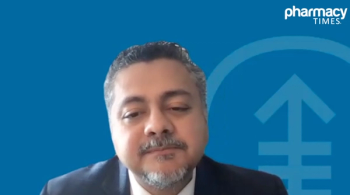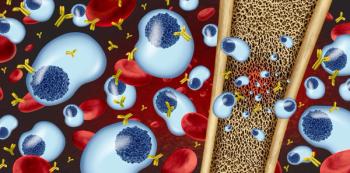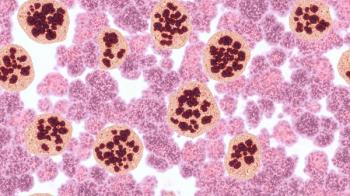
FDA Panel Rejects Belantamab Mafodotin Combinations for Multiple Myeloma, Citing Safety Concerns
Key Takeaways
- The FDA's advisory committee voted against belantamab mafodotin's use in combination regimens for relapsed or refractory multiple myeloma due to ocular toxicity concerns.
- Originally granted accelerated approval in 2020, belantamab mafodotin was withdrawn in 2023 after failing to demonstrate improved progression-free survival in a confirmatory trial.
The advisory committee cited concerns around ocular toxicity and overall tolerability, raising serious questions about the drug's benefit-risk profile ahead of its scheduled Prescription Drug User Fee Act action date on July 23, 2025.
Belantamab mafodotin’s (Blenrep; GSK) return to the US market hit a significant hurdle as the FDA’s Oncologic Drugs Advisory Committee (ODAC) voted against its use in 2 proposed combination regimens for relapsed or refractory multiple myeloma (RRMM). The advisory committee cited concerns around ocular toxicity and overall tolerability, raising serious questions about the drug's benefit-risk profile ahead of its scheduled Prescription Drug User Fee Act (PDUFA) action date on July 23, 2025.1
Belantamab mafodotin, a B-cell maturation antigen (BCMA)-targeting antibody-drug conjugate, was originally granted accelerated approval in 2020 based on results from the DREAMM-2 trial (NCT03525678). The approval allowed for use in adults with RRMM who had received at least 4 prior therapies. However, the drug was voluntarily withdrawn from the market in 2023 after the confirmatory DREAMM-3 trial (NCT04162210) failed to demonstrate improved progression-free survival, the trial’s primary end point.2-4
At the latest ODAC meeting, the panel voted 5-3 against the benefit-risk profile of belantamab mafodotin in combination with bortezomib (Velcade; Takeda Pharmaceuticals) and dexamethasone. An even stronger majority, 7-1, voted against its use with pomalidomide (Pomalyst; Bristol Myers Squibb) and dexamethasone. These votes reflect skepticism regarding the agent’s tolerability and the severity of its adverse effects, particularly eye-related toxicities.5
According to FDA briefing documents, “the key safety issue with belantamab mafodotin is ocular toxicity, including keratopathy (changes in the corneal epithelium), visual acuity changes, and other ocular symptoms, such as blurred vision and dry eye.” The ODAC also highlighted that across the DREAMM-7 and DREAMM-8 studies, dose interruptions and reductions were common. Fewer than 50% of patients in each trial could maintain the intended dose by cycle 3 of treatment.6
Despite these concerns, some experts continue to see potential for the drug in certain patient populations.
“Belamaf is clearly an active agent for the treatment of [MM] and offers an additional treatment option for patients while having notable ocular toxicities,” explained Matthew Lei, PharmD, BCOP, a clinical pharmacy specialist in lymphoma at the Massachusetts General Hospital in Boston and Pharmacy Practice in Focus: Oncology editorial advisory board member, in an email correspondence.
“With optimal supportive care and monitoring, as well as modifications to dosing and dosing schedule, belamaf can be tolerable and represents a promising combination partner in the multiple myeloma armamentarium with a different set of logistical and adverse effect considerations compared to T-cell engagers and CAR T-cell therapies,” he continued. “The questions that were voted on at the FDA ODAC meeting should be coupled with acknowledgement of the complex treatment journeys that patients with [MM] travel with their oncologists and care teams, who would be tailoring and optimizing the dosing and schedule of their treatments at each line of therapy.”
Email correspondence with another pharmacy expert, who has requested to remain anonymous, also shared his thoughts with Pharmacy Times.
"ODAC voting against belantamab, although it showed survival benefit in one of the trials, is telling us that we need to put a bigger emphasis on the patients’ quality of life. What’s the point of having a longer survival when one is wrecked with toxicities?"
Although ODAC's vote is nonbinding, it often informs the FDA's final regulatory decision. For now, the future of belantamab mafodotin in combination therapy remains uncertain as the manufacturer works to address safety concerns and explore potential pathways forward.
REFERENCES
1. GSK provides update on US FDA advisory committee review of Blenrep (belantamab mafodotin-blmf) combinations for patients with relapsed/refractory multiple myeloma. GSK. July 17, 2025. Accessed July 18, 2025. https://www.gsk.com/en-gb/media/press-releases/gsk-provides-update-on-us-fda-advisory-committee-review-of-blenrep-belantamab-mafodotin-blmf-combinations-for-patients-with-relapsedrefractory-multiple-myeloma/
2. Gerlach A. Is belantamab mafodotin making a comeback?. Pharmacy Times. June 27, 2025. Accessed July 18, 2025. https://www.pharmacytimes.com/view/is-belantamab-mafodotin-making-a-comeback-
3. A study to investigate the efficacy and safety of two doses of GSK2857916 in participants with multiple myeloma who have failed prior treatment with an anti-CD38 antibody. Updated October 23, 2024. Accessed June 27, 2025. https://clinicaltrials.gov/study/NCT03525678
4. Study of single agent belantamab mafodotin versus pomalidomide plus low-dose dexamethasone (Pom/Dex) in participants with relapsed/refractory multiple myeloma (RRMM) (DREAMM-3). Updated June 10, 2025. Accessed June 27, 2025. https://clinicaltrials.gov/study/NCT04162210
5. Bassett M. Myeloma drug's comeback nixed by FDA panel. MedPage Today. July 17, 2025. Accessed July 18, 2025. https://www.medpagetoday.com/hematologyoncology/myeloma/116562?xid=nl_mpt_Oncology_update_2025-07-18&mh=6d2b5f4f91352444bdf817a9c17750bc&zdee=gAAAAABm4uL9FCoIf1N83nrcwYYqnQUvN6Iw4dbaY-dGva4sOp57nSM2Ew3wD87ohRuoseQBDbCp1MG30J6ETpHXK1wNpp0NgnGTMFXrtFaNfWUoL5ekf-Y%3D&utm_source=Sailthru&utm_medium=email&utm_campaign=Automated%20Specialty%20Update%20Oncology%20BiWeekly%20FRIDAY%202025-07-18&utm_term=NL_Spec_Oncology_Update_Active
6. US Food and Drug Administration. FDA Briefing Document: Oncologic Drugs Advisory Committee Meeting—Belantamab Mafodotin. Silver Spring, MD: Center for Drug Evaluation and Research; 2025. Accessed July 18, 2025. https://www.fda.gov/media/187578/download
Newsletter
Stay informed on drug updates, treatment guidelines, and pharmacy practice trends—subscribe to Pharmacy Times for weekly clinical insights.




















































































































































































































